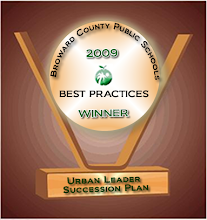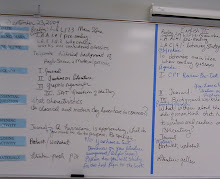Schools struggling with AYP should look to the example of dozens of their counterparts around them that have taken a personal approach to raising test scores. Instead of applying broad academic policies and sending teachers to statewide conferences to learn about new teaching methods, these schools use data to gauge student progress at any point during the school year, and then use the information to customize curriculum and instructional programs. The data informs the schools when and where interventions are necessary.
What strategies will you use to attain 72% scoring at or above grade level in Reading?
What strategies will you use to attain 74% scoring at or above grade level in Math?
Friday, September 18, 2009
Subscribe to:
Post Comments (Atom)








16 comments:
Dr. Ryan Reardon (Oriole_1831): Comment on Math Strategies:
By implementing a homogeneous student grouped model teachers @ OES are able to prepare their instruction to their students with the advantage of knowing where their children are academically in this respective content area.
This coupled with flexible grouping within the classroom and strand analysis (mini-assessments) allow individual weaknesses (and strengths) to be exposed and instruction applied.
Through the use of differentiated instruction across this content area whether a child "gets it" or "doesn't get it" he/she will receive teaching to their ability.
Students who need additional intervention - IE Tiers will be entered into the RtI process.
Reading - We utilize a walk-to-read program that allows us to maintain a small class size for our intervention group. Our specials teachers have been trained in specific reading strategies/programs to provide additional support in those intervention groups in grades 3-5. Classroom teachers provide additional support to the lowest quartile students based on individual need. Additional support staff assist in the VE classrooms to meet the needs of the SWD. High achieving students are grouped together and provided enrichment and extension activities.
Math - We have not made AYP for the past two years in our SWD subgroup. We have identified these students and have held data chats with the classroom teachers to review individual student needs. These needs will be updated based on the results of the BAT administration. Teachers utilize mini-benchmark assessments and Strand Weakness as provided in Virtual Counselor to group students for remediation and reassessment.
Reading Strategy- At my school, every year it is a challenge to meet AYP in the ELL category. We have implemented the use Rosetta Stone ILS and identified ESOL students that would benefit from this language building software.
Math- For our ILS system we post assignments directly related to the instructional focus that the grade level is currently working on. We then monitor the results on a weekly basis.
All students who scored Level I and II in reading and math are double dosed with an intensive class.
Data is compiled indicating the following: students within a 15 point range of Level III (above or below); students who went from Level IV or V to Level III or below; all students with AYP subcategory and strand results. This data was provided to all teachers and teachers are honing in on specific strands to ensure specific skills are addressed.
Reading and math coaches are providing "PUSH-INS" to focus on students identified as close to proficiency and at risk for decreasing at least one level.
Staff development is in progress for ELL and ESE to ensure teachers will use designated strategies and that individual student needs are met.
All students scoring Level 1 or 2 on FCAT reading and/or math are double dosed with an intensive class.
The following data was provided to teachers so they can hone in on specific deficiencies by strand individually and by class, address students at risk of decreasing scores to below proficiency, and address AYP subcategories to ensure students academic needs are being met: students who scored within 15 points above or below proficiency level 3; students who scored level 4 or 5 in 2008 and decreased to level 3 or below in 2009; specific deficiencies/trends in FCAT strands for both math and reading.
Reading and Math Coaches provide after-school math tutoring, push-ins and staff development, amongst their other responsibilities. FCAT camp will be provided for 15 weeks beginning October 10, 2009.
Staff development is in progress for ESE and ELL strategies to ensure the needs of these students are met.
In an effort to address the diverse needs of students in the various AYP groups, the staff will receive Differentiated Instruction staff development which will provide the opportunities for students to receive small group instruction in all content area.
FCIM will be implemented with emphasis on frequent student progress monitoring to ensure mastery of benchmarks.
Conducting diagnostic screening on all Level 1 and 2 students to prescribe effective interventions using research based programs from the struggling readers and math chart.
Reading-students have been identified and meet with reading coach 7:35-8:00 a.m. in computer lab to work on specific benchmarks
Math-students have been identified and meet with math coach 7:35a.m. 8:00 a.m.in media center.
Comment on Reading Strategy. We have implemented a 90 minute 1st period block where all teachers have a class and the first 30 minutes is an extended learning opportunity for all content areas. Language Arts and Social Studies supports reading strategies while Math and Science takes turns supporting each other.
This block also allows those students in need of Intensive Reading to have the required time and an elective as well. If and when needed the elective period will serve as a double dose of remediation and/or enrichment.
We are using a number of strategies starting with identifying students by AYP category in each class, getting baseline data, placing students into differentiated groups in reading and math based upon identified academic needs. Student progress is regularly monitored and supplemental interventions are applied based on progress. These interventions vary from additional instructional time on needed areas, to supplemental materials, FCAT camp, and SES tutoring. We achieved 90% of the AYP criteria last year and fully expect to make up the gap this year.
Comment on Math Strategy--All math classes have structured daily warm ups aligned with our school wide secondary IFC benchmark. The warm ups are modeled by the teachers after attempted by the students and then the skill is assessed through our monthly mini-assessment at the end of the month. We saw significant gains last year with this model although we did not begin it until January and did not implement the mini-assessment with fidelity. Through careful monitoring, we have started day one and fully implemented the assessment and rememdiation piece.
Our strategy for reading and math at CLMS starts with the student data chats. We are pulling our students into the Kiva 4 classes at a time. We are having students chart their data emphasizing the recent BAT test. They will write goals for the school year based on their data and include the action steps they need to take to get to those goals.
The faculty all received a book "The Differentiated Classroom" that is being jigsawed in the PLCs twice a week. Differentiated activities targeting AYP subgroups will be developed and modeled and implemented by our teachers in the classroom.
My best strategy for reading and math starts with the student data chats. We are pulling our students into the Kiva 4 classes at a time. We are having students chart their data emphasizing the recent BAT test. They will write goals for the school year based on their data and include the action steps they need to take to get to those goals.
Faculty members received the book "The Differentiated Classroom". Each department is in the process of jigsawing the book. Teachers are modeling and implementing differentiated strategies targeting AYP subgroups and will discuss and give feedback at weekly PLC meetings.
The first thing we do at RMS is to create a master schedule that will meet the needs of a diverse group of students. Student schedules are customized to meet the needs of each student based upon standardized test scores as well as past academic performance.
We support teachers in looking closely at their data to determine the needs of the students enrolled in their class. Teachers are trained in the philosophy of Differentiated Instruction. District trainers are currently working with our teachers providing additional training and support to improve the craft of differentiating the instruction to meet the needs of their students.
Reading across the content areas is a focus at RMS this year. All in house training is dedicated to providing teachers with reading strategies that can be infused in all curriculum areas.
Not only are my reading teachers sitting and discussing student individual data, but all teachers are. They have come up with some very creative ways to do so and continue to teach. Data chats are informal ways at Tequesta for our students to realize that they actually do have responsibility for their education. Getting the parent involved through conferences and acknowledgment signatures has been are hugs success. Our new reading and math coaches are presenting strategies to all subject areas in order for all teachers to assist in increasing student achievement.
The RTI/DOE visits are helpful when you begin to reflect on your practices within the school building. I encourage all schools to take the information and apply it to the "study" piece of the PDSA (Plan, Do, Study, and Act) cycle. Ask meaningful reflective questions to your leadership teams and untangle what may be clear to an observing eye. It may be frustrating, but will be well worth applying the suggestions, recommendations, and the mandates to your processes.
Post a Comment